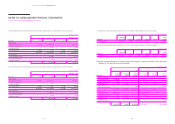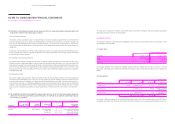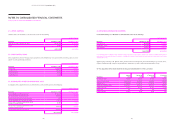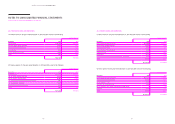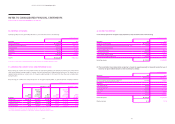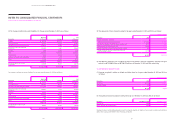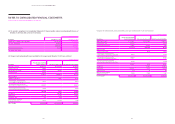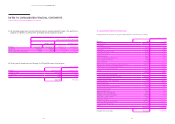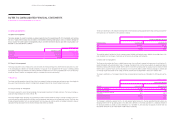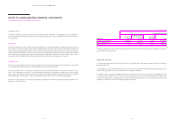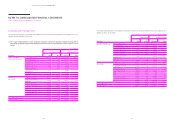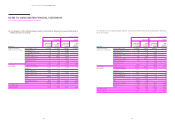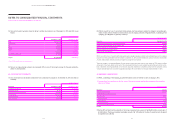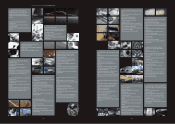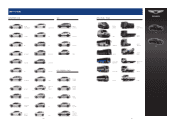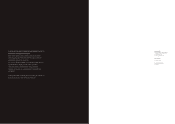Hyundai 2015 Annual Report Download - page 82
Download and view the complete annual report
Please find page 82 of the 2015 Hyundai annual report below. You can navigate through the pages in the report by either clicking on the pages listed below, or by using the keyword search tool below to find specific information within the annual report.
HYUNDAI MOTOR COMPANY Annual Report 2015
162 163
The Group’s sensitivity to a 5% change in exchange rate of the functional currency against each foreign currency on income be-
fore income tax as of December 31, 2015 would be as follows:
In millions of Korean Won
Foreign Exchange Rate Sensitivity
Foreign Currency Increase by 5% Decrease by 5%
USD ₩ (51,895) ₩ 51,895
EUR 301 (301)
JPY (34,872) 34,872
The sensitivity analysis includes the Group’s monetary assets, liabilities and derivative assets, liabilities but excludes items of in-
come statements such as changes of sales and cost of sales due to exchange rate fluctuation.
b) Interest rate risk management
The Group has borrowings with fixed or variable interest rates. Also, the Group is exposed to interest rate risk arising from fi-
nancial instruments with variable interest rates. To manage the interest rate risk, the Group maintains an appropriate balance
between borrowings with fixed and variable interest rates for short-term borrowings and has a policy to borrow funds with fixed
interest rates to avoid the future cash flow fluctuation risk for long-term debt if possible. The Group manages its interest rate
risk through regular assessments of the change in market conditions and the adjustments in nature of its interest rates.
The Group’s sensitivity to a 1% change in interest rates on income before income tax as of December 31, 2015 would be as fol-
lows:
In millions of Korean Won
Interest Rate Sensitivity
Accounts Increase by 1% Decrease by 1%
Cash and cash equivalents ₩ 13,421 ₩ (13,421)
Financial assets at FVTPL (5,748) 5,958
Short-term and long-term financial
instruments 8,211 (8,211)
Borrowings and debentures (115,450) 115,450
Financial liabilities at FVTPL 3,565 (3,565)
The Company’s subsidiaries, Hyundai Card Co., Ltd. and Hyundai Capital Services, Inc., that are operating financial business, are
managing interest rate risk by utilizing value at risk (VaR). VaR is defined as a threshold value which is a statistical estimate of
the maximum potential loss based on normal distribution. As of December 31, 2015 and 2014, the amounts of interest rate risk
measured at VaR are ₩ 131,521 million and ₩ 119,847 million, respectively.
NOTES TO CONSOLIDATED FINANCIAL STATEMENTS
AS OF AND FOR THE YEARS ENDED DECEMBER 31, 2015 AND 2014
35. RISK MANAGEMENT:
(1) Capital risk management
The Group manages its capital to maintain an optimal capital structure for maximizing profit of its shareholder and reducing
the cost of capital. Debt to equity ratio calculated as total liabilities divided by total equity is used as an index to manage the
Group’s capital. The overall capital risk management policy is consistent with that of the prior year. Debt to equity ratios as of
December 31, 2015 and 2014 are as follows:
In millions of Korean Won
Description December 31, 2015 December 31, 2014
Total liabilities ₩ 98,486,545 ₩ 84,604,552
Total equity 66,881,401 62,620,565
Debt-to-equity ratio 147.3% 135.1%
(2) Financial risk management
The Group is exposed to various financial risks such as market risk (foreign exchange risk, interest rate risk and price risk), cred-
it risk and liquidity risk related to its financial instruments. The purpose of risk management of the Group is to identify potential
risks related to financial performance and reduce, eliminate and evade those risks to an acceptable level of risks to the Group.
Overall, the Group’s financial risk management policy is consistent with the prior period policy.
1) Market risk
The Group is mainly exposed to financial risks arising from changes in foreign exchange rates and interest rates. Accordingly, the
Group uses financial derivative contracts to hedge and to manage its interest rate risk and foreign currency risk.
a) Foreign exchange risk management
The Group is exposed to various foreign exchange risks by making transactions in foreign currencies. The Group is mainly ex-
posed to foreign exchange risk in USD, EUR and JPY.
The Group manages foreign exchange risk by matching the inflow and the outflow of foreign currencies according to each cur-
rency and maturity, and by adjusting the foreign currency settlement date based on its exchange rate forecast. The Group uses
foreign exchange derivatives; such as currency forward, currency swap, and currency option; as hedging instruments. However,
speculative foreign exchange trade on derivative financial instruments is prohibited.


